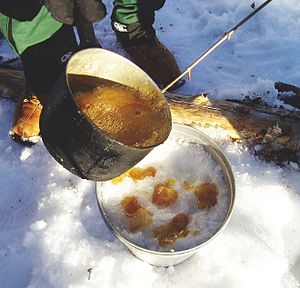Maple taffy
 Molten syrup being poured on clean white snow to create the soft maple candy. | |
| Alternative names | Maple taffee, tire d'érable, sugar on snow |
|---|---|
| Course | Dessert |
| Place of origin | Canada; United States |
| Region or state | Quebec, Eastern Ontario, New Brunswick, Manitoba; New England |
| Serving temperature | Cold |
| Main ingredients | Maple syrup, snow |
Maple taffy (sometimes maple toffee in English-speaking Canada, tire d'érable in French-speaking Canada; also sugar on snow in the United States) is a sugar candy made by boiling maple sap past the point where it would form maple syrup but not so long that it becomes maple butter or maple sugar. It is part of traditional culture in Quebec, Eastern Ontario, New Brunswick and northern New England. In these regions, it is poured onto the snow and then lifted either with a small wooden stick, such as a popsicle stick, or a metal dinner fork. The event in New England is called a sugar on snow party, and the soft candy is traditionally served with donuts, sour dill pickles, and coffee.[1] The pickles and coffee serve to counter the intense sweetness of the candy. Maple taffy is also made in the Canadian province of Manitoba using Manitoba Maple syrup, which is made from the Manitoba Maple tree (also known as a Box Elder). The syrup and taffy produced from a Manitoba Maple are generally darker and have a mustier flavour than that which is made from sugar maples.
The candy is made by boiling maple syrup to about 112 °C (234 °F). It is best to use a candy thermometer. The thick liquid may be kept hot over a very low flame or in a pan of hot water, but should not be stirred as it will form grainy crystals. This liquid is then poured in a molten state upon clean snow, whereupon the cold causes it to rapidly thicken. If the syrup runs rather than hardens when it is poured on the snow, then it has not yet been boiled long enough to make the soft maple candy. Once sufficiently hardened the candy can be picked up and eaten. The higher a temperature one boils the initial syrup, the thicker the final result will be. As it is popularly eaten soft it is usually served fresh. It is most often prepared and eaten alongside the making of maple syrup at a sugar house or cabane à sucre.
See also
References
- ^ Zimmer, Erin (2009-04-06). "Sugar on Snow: Maple Syrup on Snow Snack in Vermont". Serious Eats. Retrieved 2016-06-15.
